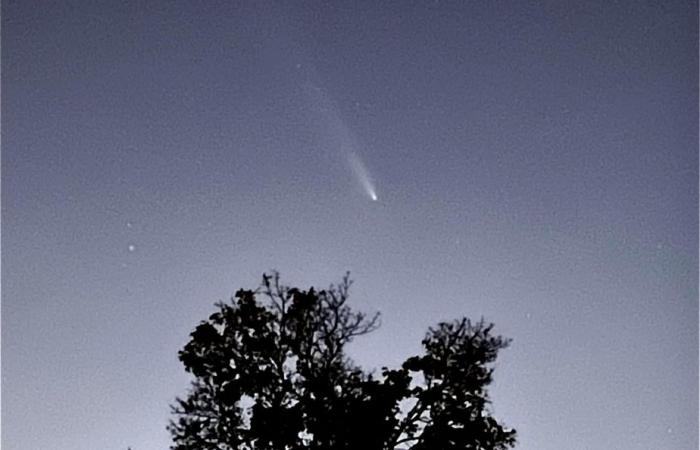Comet Tsuchinshan-ATLAS will be visible this evening in Quebec, between 7 p.m. and 8:30 p.m. Amateur astronomers have been able to see it since the beginning of the week and the show continues for a few days.
Published at 4:50 p.m.
“The comet is a little less visible than we would have hoped,” explains Olivier Hernandez, director of the Montreal Planetarium. “It lost pieces as it passed behind the sun. But with a phone in Montreal, you can still photograph it. And in places with less light pollution it can be seen with the naked eye. »
The comet passed behind the sun in late September, coming within 0.4 astronomical units (AU, the distance between the Earth and the Sun) on September 27. It started to be visible again a week ago, but in Montreal there were clouds then.
“We could see it on October 12, then there were clouds,” says Mr. Hernandez. But since yesterday it’s been quite clear. »
Tsuchinshan-ATLAS, discovered in early 2023 by Chinese and South African astronomers who gave it their names, passed closest to the Earth on October 13, at 70 million kilometers, or 0.46 AU. It is currently at 0.53 AU.
The visibility of comets follows a scale created by Ptolemy, Greek geographer and astronomer of the IIe century. The Sun has a magnitude of -27, the Moon -12, Venus and Jupiter -2, and a celestial object must have a magnitude less than +5 or +6 for it to be visible, according to Mr. Hernandez.
“What was expected before the comet passed behind the Sun was a luminosity of -3 as close as possible to the Earth on October 13, and we measured -2.5 which is very good. Currently we measure +4 and it will continue to rise above 5 or 6 in the next 2-3 days. »
A magnitude of 0 is therefore very good brightness.
Look West
The comet will be visible when looking west. “We can follow the end of the Big Dipper to arrive at the star Arcturus, which is very visible, and then easily find the location of the comet,” explains Alain Vézina, of the Astronomical Society of the Montreal Planetarium, who created a star map for The Press from astronomy software. The sky map shows the comet’s location at 7 p.m., at full twilight, over the next few days. From 7 p.m. it descends downwards.
The full moon complicates observation. “You have to look closest to 7 p.m. so as not to have too much light from the moon,” says Mr. Hernandez. After 8:30 p.m. today the comet will be located below the horizon.
Although the comet is not visible to the naked eye it can still be visible in a phone photo, up to a magnitude of +7 or +8.
Oort Cloud
This comet comes from a region of the solar system called the Oort cloud, where most comets arrive. It moves away up to 270 AU from the Sun and will return near the Earth in 80,000 years, according to Mr. Hernandez. For comparison, the two Voyager probes are currently 135 and 165 AU from Earth, according to NASA.
Comets have three “tails”. Only one, the dust tail, is visible to the naked eye for Tsuchinshan-ATLAS. There is also a tail of ionized gas and a third composed of dust particles left behind a comet, which when viewed from Earth can appear to be located in front of the comet, Hernandez said. This “antique” for Tsuchinshan-ATLAS can be visible with a 5 to 15 second exposure with a camera.
The tail of a comet can be more than 100,000 km long, with a core weighing several hundred or thousands of tons. But it is difficult to estimate this mass. “Preliminary size estimates for C/2023 a3 were 20-40 km,” says Hernandez. Then it went down to around 3-6 km, but it is so uncertain that the Jet Propulsion Laboratory (NASA editor’s note) does not include it in its database or ephemeris calculation. »
See The trajectory of Comet Tsuchinshan-ATLAS (in English)
Learn more
-
- 0,0
- Magnitude of visibility of comet Hyakutake in 1996
Source: nasa
- -1
- Magnitude of visibility of comet Hale-Bopp in 1996
Source: nasa
-
- 0,5
- Magnitude of visibility of comet NEOWISE in 2020
Source: nasa






